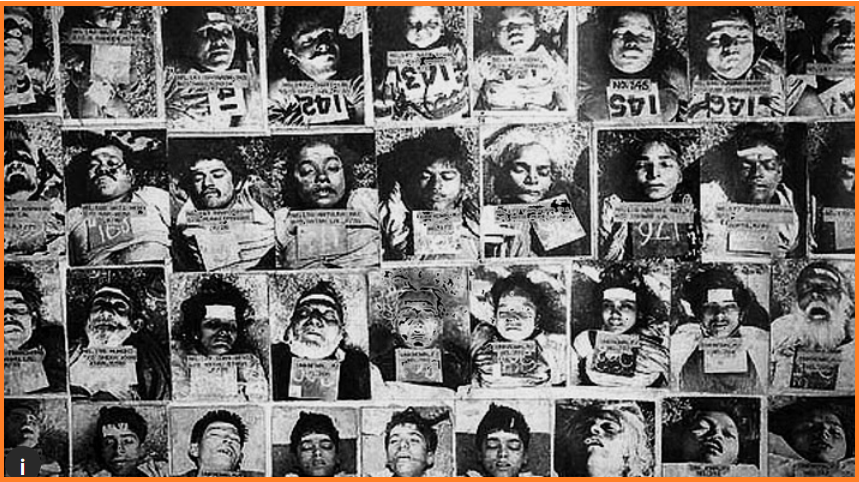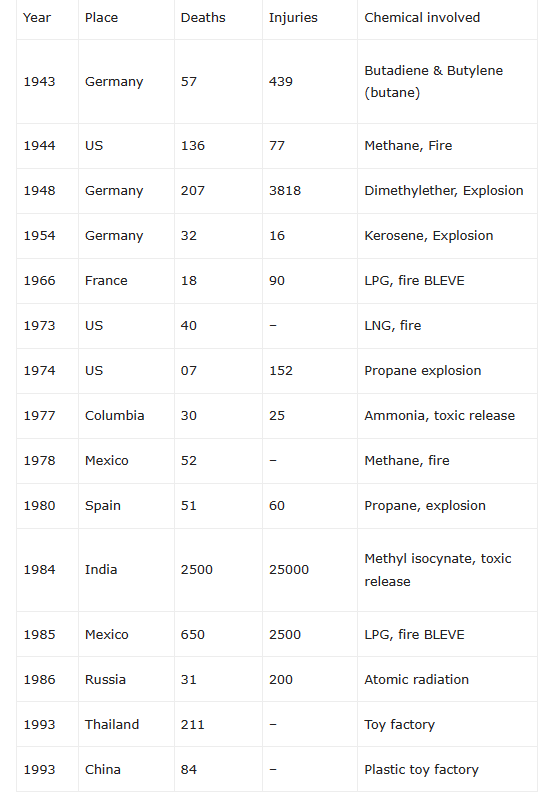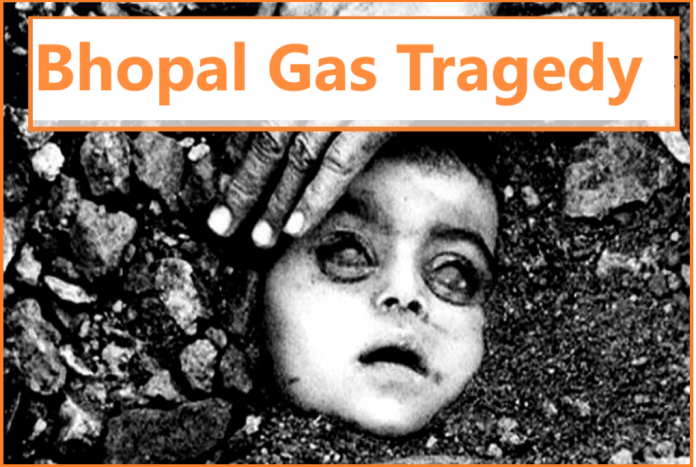The Bhopal Gas Tragedy, one of the most devastating industrial disasters in history, occurred on the night of December 2-3, 1984, in the city of Bhopal, Madhya Pradesh, India. The incident took place at the Union Carbide India Limited (UCIL) pesticide plant, releasing a toxic gas known as methyl isocyanate (MIC) into the surrounding areas. The aftermath of the disaster left an indelible mark on the lives of thousands and raised serious concerns about industrial safety, corporate responsibility, and the impact of technological disasters on communities.
Contents
Background of Union Carbide Corporation:
Union Carbide Corporation, an American multinational chemical company, established its subsidiary, Union Carbide India Limited, in Bhopal to manufacture pesticides. The plant began its operations in 1979, producing pesticides such as Sevin (carbaryl). The manufacturing process involved the use of highly toxic chemicals, including methyl isocyanate, which is known for its extreme volatility and toxicity.
The Disaster Unfolds:
On the fateful night of December 2-3, 1984, a series of events led to the catastrophic release of toxic gas from the plant. A combination of factors, including inadequate safety measures, poor maintenance, and operational negligence, contributed to the tragedy. Water entered a storage tank containing methyl isocyanate, triggering a violent chemical reaction that raised the temperature and pressure within the tank.
The safety systems in place were inadequate to handle such an emergency, and as a result, a large volume of lethal gas was released into the atmosphere. The gas quickly spread through the neighboring communities, engulfing the densely populated areas surrounding the plant. The unsuspecting residents were exposed to the toxic fumes while they slept, leading to immediate and long-term health consequences.

Immediate Impact:
The immediate impact of the gas leak was catastrophic. Thousands (Approx 25000) of people were killed over the year, and many more suffered from severe respiratory and ophthalmic issues. The gas caused widespread panic as people tried to escape the invisible and odorless killer. Hospitals were overwhelmed with the sheer number of patients suffering from respiratory distress, eye irritation, and other toxic effects.
The inadequate medical infrastructure in Bhopal at the time further compounded the crisis, making it challenging to provide timely and effective treatment to the victims. The lack of information about the nature of the gas and the absence of proper emergency response plans exacerbated the already dire situation.
List of worldwide major accident:

Long-Term Consequences:
The aftermath of the Bhopal Gas Tragedy has had far-reaching consequences on the health and well-being of the affected population. Many survivors continue to suffer from chronic respiratory problems, neurological disorders, and other long-term health issues. The toxic exposure has also led to a higher incidence of birth defects and disabilities among the second and third generations of the survivors.
The environmental impact of the disaster is another dimension of its long-term consequences. The soil and water in and around the plant were contaminated with toxic chemicals, affecting the local ecosystem and agricultural activities. The long-term effects on biodiversity and the food chain are still being studied, highlighting the enduring environmental cost of industrial negligence.
Legal and Ethical Implications:
In the aftermath of the Bhopal Gas Tragedy, legal battles ensued to hold Union Carbide accountable for the disaster. The Indian government and victims’ groups sought compensation for the victims and punitive measures against the responsible parties. In 1989, Union Carbide and the Indian government reached a settlement for $470 million – [38,671,835,000 (INR)], a figure widely criticized as inadequate given the scale of the disaster and its long-term impact.
The legal proceedings raised ethical questions about corporate responsibility and the accountability of multinational corporations operating in developing countries. The Bhopal case highlighted the need for international standards in environmental and industrial safety and emphasized the importance of stringent regulations to prevent similar disasters in the future.
Corporate Responsibility and Lessons Learned:
The Bhopal Gas Tragedy remains a stark reminder of the consequences of neglecting safety protocols and corporate responsibility. The disaster prompted a global reevaluation of industrial practices and spurred discussions on the ethical obligations of corporations operating in diverse cultural and economic contexts.
Governments and regulatory bodies worldwide began to reexamine and strengthen safety regulations for industries dealing with hazardous substances. The incident led to the establishment of the concept of Responsible Care, an initiative within the chemical industry aimed at improving environmental, health, and safety performance.
International Collaboration and Advocacy:
The Bhopal Gas Tragedy sparked international collaboration and advocacy for the victims’ rights and environmental justice. Non-governmental organizations (NGOs), activists, and concerned citizens rallied to support the victims and demanded justice. The incident fueled a broader movement for corporate accountability and responsible business practices, transcending geographical boundaries.
The tragedy also prompted discussions on the ethical implications of globalization and the need for a coordinated international response to industrial disasters. The United Nations and other international organizations began to emphasize the importance of a global framework for environmental protection and human rights, acknowledging the interconnectedness of the world in addressing such crises.
The Bhopal Gas Tragedy stands as a somber reminder of the devastating impact of industrial negligence on human lives and the environment. The incident has left an enduring legacy, shaping discussions on corporate responsibility, environmental justice, and the ethical dimensions of technological disasters.
While significant strides have been made in improving industrial safety standards since the Bhopal Gas Tragedy, challenges persist. The incident underscores the need for continued vigilance, stringent regulations, and corporate accountability to prevent similar disasters in the future. As we reflect on this dark chapter in industrial history, it is crucial to honor the memory of the victims and strive for a world where the pursuit of profit never comes at the expense of human lives and the well-being of our planet.
FAQ for Bhopal Gas Tragedy
Q1: What was the Bhopal Gas Tragedy?
A1: The Bhopal Gas Tragedy refers to the catastrophic industrial disaster that occurred on the night of December 2-3, 1984, in Bhopal, India. It involved the release of a lethal gas, methyl isocyanate (MIC), from the Union Carbide India Limited (UCIL) pesticide plant, leading to thousands of immediate casualties and long-term health and environmental consequences.
Q2: What caused the Bhopal Gas Tragedy?
A2: The tragedy was caused by a combination of factors, including inadequate safety measures, poor maintenance, and operational negligence at the Union Carbide plant. Water entered a storage tank containing MIC, triggering a violent chemical reaction that led to the release of toxic gas into the surrounding areas.
Q3: What were the immediate consequences of the gas leak?
A3: The immediate consequences were devastating, with thousands of people killed within hours. Many survivors suffered from severe respiratory and ophthalmic issues. Hospitals were overwhelmed, and the lack of information about the gas and the absence of proper emergency response plans exacerbated the crisis.
Q4: What were the long-term consequences of the Bhopal Gas Tragedy?
A4: The long-term consequences include chronic health issues among survivors, such as respiratory problems and neurological disorders. There is also a higher incidence of birth defects and disabilities among the second and third generations of the affected population. The environmental impact led to soil and water contamination, affecting the local ecosystem and agricultural activities.
Q5: How did the legal proceedings unfold after the tragedy?
A5: Legal battles ensued to hold Union Carbide accountable for the disaster. In 1989, a settlement was reached between Union Carbide and the Indian government for $470 million, a figure criticized as inadequate. The legal proceedings raised ethical questions about corporate responsibility and the accountability of multinational corporations.
Q6: What is Responsible Care, and how is it related to the Bhopal Gas Tragedy?
A6: Responsible Care is an initiative within the chemical industry aimed at improving environmental, health, and safety performance. The Bhopal Gas Tragedy played a significant role in highlighting the importance of responsible business practices, leading to the establishment of Responsible Care as a commitment to enhancing industry standards.
Q7: How did the Bhopal Gas Tragedy impact international collaboration and advocacy?
A7: The tragedy sparked international collaboration and advocacy for the rights of the victims and environmental justice. NGOs, activists, and concerned citizens rallied to support the victims and demand justice. The incident fueled a broader movement for corporate accountability and responsible business practices, transcending geographical boundaries.
Q8: What lessons have been learned from the Bhopal Gas Tragedy?
A8: The Bhopal Gas Tragedy emphasized the need for stringent safety regulations, corporate accountability, and responsible business practices. It prompted international discussions on the ethical implications of globalization and the importance of a coordinated global response to industrial disasters. The incident remains a reminder of the lasting impact of neglecting safety protocols and the need for continued vigilance.





